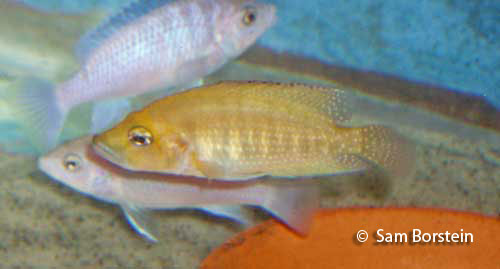Altolamprologus compressiceps
(Boulenger, 1898)
Comps, Compressed Lamprologus
Synonyms: Lamprologus compressiceps

Above: A female "Gold" Altolamprologus compressiceps. Photo by Sam Borstein.
Etymology:
Genus- Altus= High (Latin), lampas= Bright (Latin), lagos= hare (Greek).
Species- compressi= compressed (Latin), ceps= head (Latin) .
Intro:
Altolamprologus compressiceps gets its name because it iss laterally compressed, which gives these fish some advantages. One is being able to eat fry out of small cracks in the rocks. Another is to hide and breed in a crack that other fish will have trouble attacking.This fish also comes in many color types
- Gold- pictured above.
- Gold Head- Black with a gold head. Pictured bellow.
- yellow- a really yellow fish with light blue fins.
- Red Fin- a gold fish with red fins.
- Gold Head Red Fin- a gold head fish with gold fins.

Above: A male Altolamprologus compressiceps "Gold Head". Photo by Rick Borstein.
Distribution:
Altolamprologus compressiceps is found in the rocky areas of Lake Tanganyika.
Size, Maturity, and Sexual Dimorphism:
Size: Males- 6 inches, Females- 4 inchesMaturity: Age is key, not size. The fish have to be about two years old to start breeding, sometimes even longer. Patience is key. These fish grow at a very slow rate.
Sexual Dimorphism: Males are larger.
Care:
Altolamprologus compressiceps is easy to care for. This fish needs to feel comfortable, so use plenty of rocks. Also, do weekly water changes of 50%. This fish is sensitive to temperature change, so be careful.
Diet:
This is a predatory fish usually eating the fry of other fish. This fish will take spectrum and other meaty prepared products. They LOVE brine shrimp and bloodworms.Breeding:
Altolamprologus compressiceps takes a while to get going. First off, they need about a month to settle down. Once paired off, they will dig like crazy. The fish lay up to 100 or so eggs in a crack and are relatively good parents. Although it may look like they are trapped under a rock, they really are just protecting their eggs.
For this fish I bought a terra cotta "Toaster". This is a rectangular box that has a side open and a wall down the middle. I highly recommend using these because it makes getting babies out a lot easier, and you can see their development. Once the fish hatch feed baby brine shrimp, because the babies are super small.
This fish grows slow. I raised babies for 6 months feeding baby brine shrimp, and doing 50% water changes weekly. By the time I got rid of the babies they may have been right around half an inch.
Conclusion:
This fish, although they take forever to grow, is really nice. If you have ever had Altolamprologus calvus, these fish are very similar. If you liked Altolamprologus calvus, you should give Altolamprologus compressiceps a try. This fish is common but can be on the expensive side. If you like Tanganyikans pick a pair up.
References:
- Boulenger, G. A. (1898). Report on the fishes recently obtained by Mr. J. E. S. Moore in Lake Tanganyika. Proceedings of the Zoological Society of London, 494-497.
- Konings, A. (1998) Tanganyikan cichlids in their natural habitat. Cichlid Press, El Paso, Texas, 272 pp.
